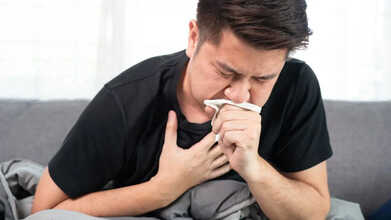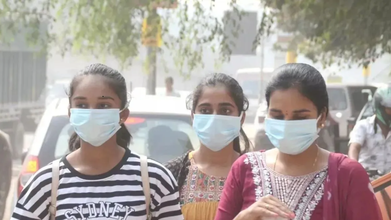- Health Conditions A-Z
- Health & Wellness
- Nutrition
- Fitness
- Health News
- Ayurveda
- Videos
- Medicine A-Z
- Parenting
Scientists Say A Type 1 Diabetes Cure May Be Close, Raising Hope for Life Without Insulin Shots

Credits: Canva
A research team at Stanford School of Medicine has reported an experimental treatment that appears to stop type 1 diabetes in its tracks in mice. The method not only prevented the disease in animals on the verge of developing it, but also restored normal blood sugar levels in mice already living with full-blown diabetes.
The approach stands out because it merges immune cells from the patient and a donor, creating a shared immune system that accepts the transplanted tissue without heavy immunosuppressive drugs. The mice remained stable for at least four months, which is considered significant in early-stage diabetes research.
Scientists believe the strategy could eventually help humans living with type 1 diabetes and may also support safer organ transplantation, as per Science Direct.
What Is Stem Cell Therapy For Diabetes?
Stem cell therapy for diabetes aims to rebuild the body’s ability to make its own insulin by creating new, working beta cells in the pancreas. In this method, stem cells collected from sources such as bone marrow or umbilical cord blood are guided to develop into insulin-producing cells. These cells are then placed into the patient’s body to help regulate blood sugar more naturally. According to the National Institutes of Health, this approach may lessen a person’s dependence on insulin shots and other diabetes medicines.
How the Hybrid Immune System Works?
Type 1 diabetes develops when the body’s own defense system begins to destroy insulin-producing beta cells in the pancreas. Replacing these cells through islet transplantation is a known option, but the recipient’s immune system often attacks the donor cells as well.
In this study, researchers first “soft-reset” the mouse immune system with a preparation process that included a targeted immune inhibitor, a small dose of radiation, and selected antibodies. Once the animals were conditioned, scientists infused a mix of donor blood stem cells and donor islet cells.
This created a blended immune environment where the new islet cells were not treated as intruders. The mice regained the ability to regulate blood sugar, and the transplanted tissue stayed largely free from destructive inflammation.
Why the Findings Matter
Lead researcher Seung Kim explained that the method addresses two challenges at once. It replaces the lost insulin-producing cells and calms the autoimmune process that caused the damage in the first place. None of the animals developed graft-versus-host disease, a serious complication that often appears in cross-donor cell therapies in humans.
The results build on earlier studies suggesting that donor-recipient immune cell combinations can help prevent transplant rejection. The promising outcome raises hope for human trials, although several hurdles remain.
What Still Needs to Be Solved?
Islet cells for transplantation can only be collected after a donor’s death, and they must come from the same person who provides the blood stem cells. The number of cells required for a human-scale procedure is also unclear.
Researchers are now exploring ways to improve the survival of donor cells and to grow replacement cells from pluripotent human stem cells in the lab. The team believes these steps could bring this treatment closer to clinical use.
Kim called the possibility of adapting the findings for people “very encouraging,” noting that some of the immune-reset techniques used in the study already exist in clinical care for other conditions.
This Sleeping Position Could Worsen A Covid Symptom, NHS Cautions

Credits: Canva
People who are dealing with a particular Covid symptom have been given a cautionary note by the NHS. The way you position yourself while resting or sleeping can actually aggravate how you feel. As cold weather settles over the UK, the chances of picking up seasonal infections such as colds, flu or COVID-19 begin to rise. These viruses thrive in lower temperatures and spread more easily when people spend more time indoors.
For most individuals, Covid clears up within a few days or a couple of weeks without needing specialised care. Because of this, the NHS advises plenty of rest to support recovery. It also recommends staying home and limiting contact with others if you have symptoms and do not feel well enough to go about your usual activities. The health service further offers specific guidance for anyone struggling with a cough.
NHS Issued A Warning For Certain Covid Symptoms
Cough remains one of the most common signs of Covid, especially when it becomes “continuous.” The NHS describes this as coughing repeatedly for more than an hour, or having three or more coughing spells in a single day.
To help ease the discomfort, the NHS advises: “Do not lie on your back if you have a cough – lie on your side or sit upright instead.”
This suggestion is echoed by Dr Elizabeth Rainbolt. In an interview with the Cleveland Clinic, she noted that lying flat on your back can worsen postnasal drip.
Why Sleeping Position Matters When You Have a Cough
For people dealing with a dry cough, resting on your side rather than on your back may help limit irritation. Dr Rainbolt added: “Raising your head is usually the best position for sleep. You can do this by adding an extra pillow or slightly lifting the head of your bed. This keeps drainage from settling at the back of your throat.”
Anyone coping with a persistent cough should speak with a pharmacist to explore available remedies.
Symptoms
Along with coughing, the NHS lists several other signs of Covid, including:
- A high temperature or shivers (chills) – a high temperature means your chest or back feels hot to the touch (you do not need to check it with a thermometer)
- A change or loss in your sense of smell or taste
- Shortness of breath
- Fatigue
- Aches in the body
- Headache
- Sore throat
- Blocked or runny nose
- Poor appetite
- Diarrhoea
- Nausea or vomiting
Covid Recovery Tips From Health Experts
- Make sure you get enough rest to support your body’s recovery.
- Drink plenty of water to stay hydrated; aim for urine that is light yellow or clear.
- Use paracetamol or ibuprofen to ease discomfort if needed.
- A teaspoon of honey may soothe a cough, but never give honey to infants under 12 months.
- For breathlessness, lower the room temperature or open a window to improve airflow.
- Practice slow, controlled breathing: inhale through your nose and exhale gently through pursed lips, like blowing out a candle.
- Sitting upright in a chair can help ease shortness of breath.
- Keep your shoulders relaxed to prevent tension that can worsen breathing.
- Lean forward slightly, supporting yourself with your hands on your knees or a stable surface, to make breathing easier.
- Avoid using fans to cool your room, as they may disperse viral particles.
- Stay calm if you feel breathless, as anxiety can intensify the sensation.
RFK Jr. Claims CDC’s Latest Vaccine–Autism Guidance Was Issued Under His Direction

Credits: Public Forum
Health Secretary Robert F. Kennedy Jr. told The New York Times that he personally instructed the U.S. Centers for Disease Control and Prevention to revise its long-standing message that vaccines do not cause autism. His disclosure, published Friday, confirms who was behind the surprising shift that caught many current and former CDC employees off guard earlier in the week.
Kennedy, who has a long history of opposing routine vaccination, has increasingly unsettled the public health agencies he now leads. His recent moves have raised concerns across the medical community, which sees many of his decisions as placing Americans at risk.
CDC Website Autism Vaccine Claim: What Kennedy Said and What Changed
In the interview, Kennedy dismissed the CDC’s previous guidance, calling the agency’s long-held position on vaccine safety “a lie.” The CDC’s updated “vaccine safety” page now argues that the statement “vaccines do not cause autism” cannot be proven with absolute certainty and implies that officials have disregarded research that hints at a possible link, as per CNN.
This new language conflicts with decades of scientific evidence and goes against the consensus view shared by independent researchers, pediatric groups and global health authorities.
How the Scientific Community Responded
Public health experts reacted sharply, warning that the revisions distort how evidence is evaluated in science. Researchers emphasized that while science cannot prove a negative, extensive data can rule out likely causes, and that is what has happened in the case of vaccines and autism, as per CNN.
Autism advocacy groups called the claim misleading. The Autism Science Foundation repeated that vaccines remain one of the most thoroughly investigated environmental factors linked to autism and that research across many countries and large populations has consistently found no association.
What the Science Actually Shows About Vaccines and Autism
Scientists have studied vaccines and autism for more than two decades. Large population studies in the United States, Europe and Asia have looked at the measles, mumps and rubella (MMR) vaccine, thimerosal-containing vaccines, and the timing of childhood immunization. Each line of research has reached the same conclusion: vaccines do not cause autism.
These findings have come from independent academic teams, government-funded studies and international health agencies, using different methods, age groups and datasets. Experts say the updated CDC wording misrepresents this evidence and may create unwarranted fear among parents, as per CNN.
A Promise Broken
Kennedy had previously assured Sen. Bill Cassidy, who chairs the Senate health committee, that he would keep the statement “vaccines do not cause autism” on the CDC website during his confirmation process. While the line remains, it now appears with a disclaimer noting that it was kept there specifically because of their agreement.
Cassidy said he opposed the update after Kennedy informed him of the change. The senator later warned that parents need clear reassurance, not confusion, especially on diseases like measles, polio and hepatitis B, where vaccination is proven to prevent severe illness.
A Wider Pattern of Disruption
The CDC website change is only one part of a broader shift under Kennedy’s leadership. He has withdrawn half a billion dollars from vaccine development initiatives, removed every member of a federal vaccine advisory panel, and signaled plans to overhaul the national vaccine injury compensation program.
He also dismissed former CDC Director Susan Monarez within weeks of her appointment after policy disagreements.
RFK Jr. Claims About The Vaccine Has Growing Distrust Within Medicine
Leaders in pediatrics and infectious disease warned Thursday that the new website language fuels misinformation rather than clarifying public health advice. Dr. Sean O’Leary of the American Academy of Pediatrics called the change “madness” and said it undermines confidence in the nation’s most basic health protections.
The Department of Health and Human Services did not respond to requests for comment.
Living In Delhi's Toxic Air Is A 'Medical Emergency', According AIIMS Doctors

Credits: ANI
As of 12pm on November 22, Delhi's AQI according to aqi.in is recorded at 315, with PM2.5 recorded at 225, and PM10 recorded at 296. The levels are still under the category 'Hazardous' and is equivalent to smoking 10.8 cigarettes a day, 75.6 cigarettes a week, and 324 cigarettes a month.
Amid all this, in an interview with the news agency ANI, AIIMS doctor called Delhi's deteriorating air quality as a "medical emergency". The doctors have warned that the crisis has intensified to a level where existing government measures are no longer enough. Prof Dr Anant Mohan, who heads the Department of Pulmonary, Critical Care, and Sleep Medicine, and Dr Saurabh Mittal of the same department at AIIMS said that city's continuously worsening pollution could pose serious threats to the vulnerable, including pregnant women, unborn and newborn child, and other adults, especially the ones with cardiac or neurological conditions.
Impact Could Be Generational
Dr Mohan highlighted that the exposure could lead to impacts which could be felt for generations. He said that the alarming effect is being seen on pregnant women, and that the pollutant, since the particles are so small, could pass through mother to the child in the fetus and could affect their growth.
The doctor pointed out that babies who are exposed to such a condition in womb have a higher chance of being born under weight, and their lungs may continue to remain weak as they grow. There could be other complications too, which might only be noted as the child grows old.
Dr Mittal said that the effects of air pollution now reach far beyond respiratory issues. He noted that prolonged exposure to toxic air has triggered rising cases of breathlessness, lung inflammation, asthma attacks, and chronic conditions like COPD. Fine particulate matter is also entering the bloodstream, raising the risk of heart attacks and strokes.
What Can You Do?
Wear N-95 Mask
The doctors are advising to wear an N-95 mask whenever someone is stepping outdoors. He mentions that a cloth or a surgical mask won't protect them against the pollutants, as N-95 masks are the only protective gears with filters that can keep the pollutants out when you breathe.
Skip Your Morning Walk
Pollution is the highest in the morning. This happens because pollutants accumulate overnight, and without wind or sunlight, PM2.5 or the particulate matter stays trapped near the ground, leading to pollution being at its peak by sunrise. As per the data by aqi.in, highest AQI is always registered between 6am to 9am.
Use Wet Mopping
Dry dusting could push the particles back up into the air, thus using a wet mop would reduce the dust particles and prevent it from being released in the air.
Vitamin C Supplements
A 2007 study published in the Journal of the Royal Society of Medicine noted that vitamin C or its supplement could in fact help patients with pneumonia or other lung-related disease. Thus vitamin C is a good boost for when lungs are at high risk, all thanks to the pollution.
Furthermore, the doctors suggest to keep hydrating yourself and use air purifier if one can afford it.
© 2024 Bennett, Coleman & Company Limited

